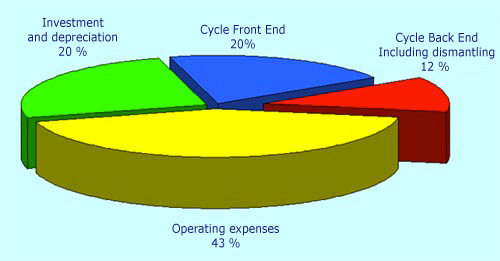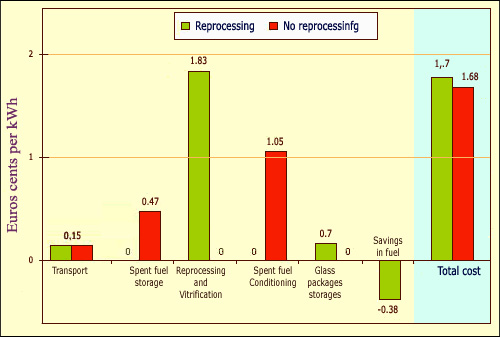Reprocessing or not reprocessing: a comparison
Which option for dealing with spent fuel from reactors costs more? Reprocessing or not reprocessing? It is hard to compare the two because the final phases of management, namely disposal or even incineration, are still being studied. According to a parliamentary report, the French geological disposal facility for high-level waste could be commissioned in 2020-2025.
In principle, not reprocessing spent fuel seems an economical option. Reprocessing is costly; it involves handling highly radioactive materials, high-temperature chemistry, and avoiding release. On the other hand, not reprocessing spent fuel involves storing radioactive waste in pools near reactors. Theoretically, and subject to effective maintenance and monitoring, storage over a few decades does not present any problem. Storage for an indefinite period, however, is not an option, no matter how effective monitoring may be. The need for careful conditioning cannot be avoided, if only because of the radioactive toxicity of plutonium. The volume of radioactive materials to be buried will be greater.
In the United States, where the Yucca Mountain spent fuel disposal site has been abandoned, attention has recently turned to reprocessed waste because of its reduced volume. One of the advantages of reprocessing is that it considerably reduces the size and, therefore, the cost of disposal facilities for ultimate waste.

Breakdown of nuclear energy generating costs
Operations relating to the back end of the fuel cycle only account for 12% of the nuclear generating cost. These operations range from extracting irradiated fuel from the reactor to the disposal of waste, including reprocessing. This figure of 12% should be compared with 20% for the front end of the cycle (uranium mining and enrichment), 15% for plant depreciation costs and, above all, 43% for operating costs.
© IN2P3 (source EDF)
In 1999, the cost of reprocessing was estimated at €62,500 per cubic metre of low- or intermediate-level long-lived waste, and €640,000 per cubic metre of high-level waste. This cost would be prohibitive if the volume of these materials were not relatively small (2700 m3 accumulated in France according to Andra’s 2012 inventory). Waste management costs are included in the nuclear generating cost and only have a slight impact on it. Furthermore, nuclear energy is the only energy source where such negative effects are included in the cost price.
Recycling plutonium with MOX fuel saves the high cost of enrichment with uranium-235, which is required for uranium fuel. MOX fabrication calls for stringent radiation protection, but in chemical terms, simply involves mixing plutonium and natural uranium oxides.

Cost of reprocessing and not reprocessing
According to a 1999 OECD study, the costs of fuel reprocessing and direct disposal are comparable. The extra cost of reprocessing is partly absorbed by the savings made by recycling plutonium to make MOX fuel. This comparison does not take into account final disposal in the future, nor does it make any allowance for the unknown cost of environmental protection achieved through waste vitrification.
© IN2P3 (Source OPECST Report)
According to the french Atomic Energy Commission (CEA), continuing fuel reprocessing and recycling in present-day PWR beyond 2010 would save 5% uranium and reduce by 12 to 15% the amount of plutonium to be managed. The overall additional cost of reprocessing and recycling was only 1.3% per kWh for the consumer in 2001, in other words 0.2 euro cents.
These comparisons do not take into account the improved environmental protection resulting from the vitrification of high-level waste. Neither do they consider the possibility of obtaining cleaner nuclear fuel that is more compatible with sustainable development, no doubt using a different reprocessing method.
Other articles on the subject « The waste issue »
Waste or resource?
Spent fuel can still generate a lot of energy The fuel removed from a reactor core after three or[...]
Fuel Reprocessing
The spent fuel reprocessing option Spent fuel reprocessing is derived from a process called the P[...]
Alternative to reprocessing
Leave fuel as it is : do not reprocess If the spent fuel does not undergo reprocessing, the fuel [...]
What to do with plutonium
A highly strategic material and a hazardous type of waste What becomes of plutonium is central to[...]
Plutonium options
Plutonium: hazardous waste or miraculous raw material? For those who advocate pulling out of nucl[...]